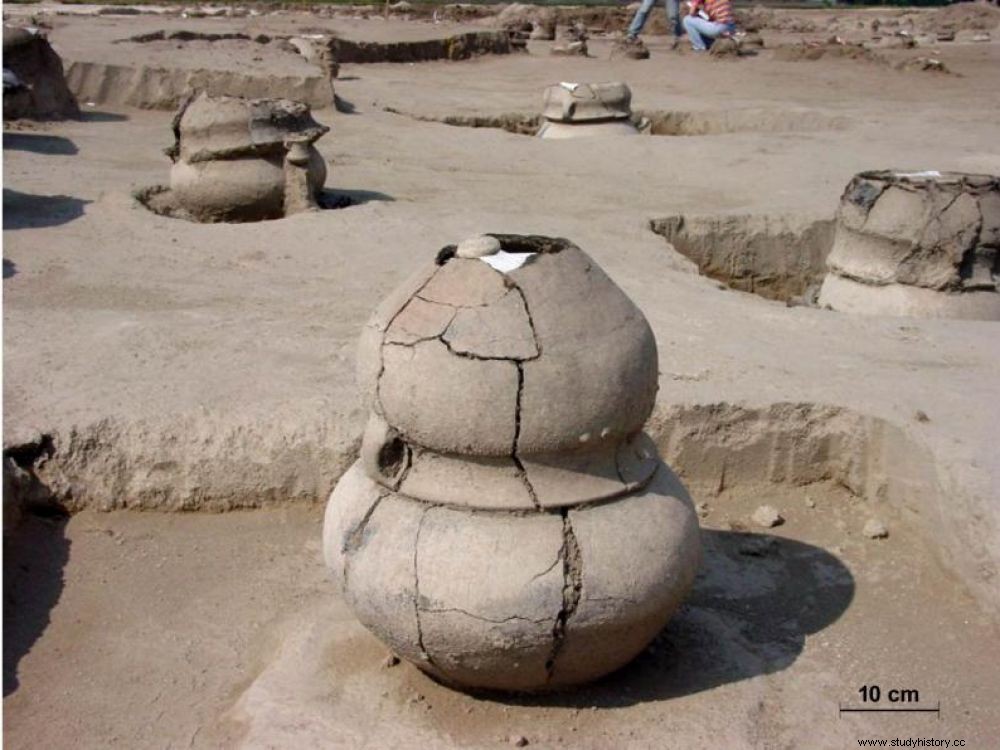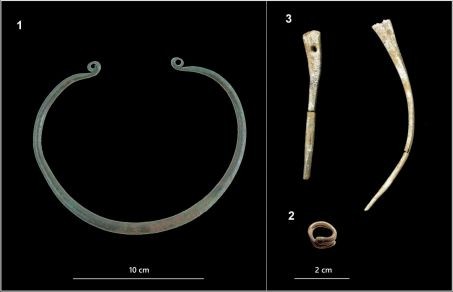The study of a Bronze Age necropolis in Hungary has made it possible to trace the population movements of this period. Thanks to this, archaeologists were able to reconstruct the course of a high-ranking woman.

Typical burial of the Vatya culture.
More than 500 Bronze Age tombs were buried in the soil of one of the largest necropolises in Hungary. An international team of archaeo-anthropologists has just studied 29 of them. Their results, published in Plos One , highlighted the story of a woman of high social status, and also confirm the story of the movement of individuals between communities of this time.
The Szigetszentmiklós-Ürgehegy necropolis was used in the Middle Bronze Age, between 2150 and 1500 BC. In the plains of central Hungary, it is the time of the Vatya culture, made up of several communities, whose economy is based on local trade, but also on longer distances. Located a few kilometers south of present-day Budapest, the necropolis is made up of 500 cremation graves and eight burials. It is typical of the necropolises called "fields of urns", grouping together hundreds of tombs, found in Europe at that time. A classic tomb in these necropolises consisted of a ceramic funerary urn, accompanied by a small cup placed inside or beside it. And one or two vases were then used as a lid to seal the urn. Ceramic tableware, bronze or bone ornaments often accompanied the deceased.
Strontium makes the bones talk
To unlock the secrets of the urn bones, scientists analyzed strontium isotopes. These chemical elements are deposited in our body during its growth, in particular through our diet. The ratio of strontium is then characteristic of the environment in which one grows. "We thus examined the isotopic composition of strontium in the petrous bone (the bone of the inner ear, editor's note) and in the teeth, which are formed at various periods of childhood and adolescence. "explains Claudio Cavazzuti, researcher at the University of Bologna and first author of the study, interviewed by Sciences et Avenir . It is thus possible to compare the ratio of these isotopes contained in the bones of the buried persons with that known from the place where they were found, which makes it possible to know whether they originated there or not.
More than 500 Bronze Age tombs were buried in the soil of one of the largest necropolises in Hungary. An international team of archaeo-anthropologists has just studied 29 of them. Their results, published in Plos One , highlighted the story of a woman of high social status, and also confirm the story of the movement of individuals between communities of this time.
The Szigetszentmiklós-Ürgehegy necropolis was used in the Middle Bronze Age, between 2150 and 1500 BC. In the plains of central Hungary, it is the time of the Vatya culture, made up of several communities, whose economy is based on local trade, but also on longer distances. Located a few kilometers south of present-day Budapest, the necropolis is made up of 500 cremation graves and eight burials. It is typical of the necropolises called "fields of urns", grouping together hundreds of tombs, found in Europe at that time. A classic tomb in these necropolises consisted of a ceramic funerary urn, accompanied by a small cup placed inside or beside it. And one or two vases were then used as a lid to seal the urn. Ceramic tableware, bronze or bone ornaments often accompanied the deceased.
Strontium makes the bones talk
To unlock the secrets of the urn bones, scientists analyzed strontium isotopes. These chemical elements are deposited in our body during its growth, in particular through our diet. The ratio of strontium is then characteristic of the environment in which one grows. "We thus examined the isotopic composition of strontium in the petrous bone (the bone of the inner ear, editor's note) and in the teeth, which are formed at various periods of childhood and adolescence. "explains Claudio Cavazzuti, researcher at the University of Bologna and first author of the study, interviewed by Sciences et Avenir . It is thus possible to compare the ratio of these isotopes contained in the bones of the buried persons with that known from the place where they were found, which makes it possible to know whether they originated there or not.
This method then made it possible to reconstruct the movements of individuals during their youth. And it was possible to see that mobility varies according to gender. The adult males would be of local origin, and would not move much outside the region. On the other hand, adult women would present large variations in their isotopic composition. They therefore probably had to move more, even if an origin outside the region was only proven for two of them. This culture had to present a patrilocal and exogamous way of life, that is to say that the unions had to be made between different communities. It was then probably the woman who had to come from an outside community to live with the family of her companion. These elements confirm the previous hypotheses put forward on the culture of Vatya:"archaeological material, such as the presence of foreign objects associated with individuals, already suggested that exogamy was commonly practiced in general at the age of the European Bronze " says Claudio Cavazzuti.
In the footsteps of a high-ranking woman
The most striking example of this phenomenon is grave 241. It contains the burnt remains of an adult individual, most likely a woman between the ages of 25 and 35, and two fetuses of 7 to 8 months old. The presence of the two fetuses suggests that she was pregnant with twins. They were accompanied by prestigious goods:a gold hair ring, a bronze necklace and two ornamental bone pins. It is a unique adornment in the necropolis, and rare among the other culture cemeteries. This marks her high social status:this woman was probably part of the local elite.

Funeral furniture from tomb 241:1. bronze necklace - 2. gold hair ring - 3. bone pin and needle © 2021 Cavazzuti et al.
His strontium signature diverges from the majority of individuals. This indicates that this woman must have arrived between the ages of 8 and 13 in this community. This is confirmed by the furniture that accompanies it. The bronze necklace could have originated either from the south-east of the Czech Republic, or from southern Austria or even from the north of the Danube valley, which corresponds to the values of the isotopes found. While the gold hair ring is typical of the region, which would perhaps symbolize her local identity, which she acquired by joining the community.
Until then, strontium was only rarely used on burnt bones, because of their very high fragmentation. Even during this study, only 29 tombs allowed analysis out of the 500 found in the necropolis. Although this technique cannot therefore be used in many cases, it is very informative. "Strontium analysis allows you to observe the mobility patterns of a population, to see to what extent society was permeable to the integration of non-local individuals ", concludes Claudio Cavazzuti. This information can thus shed light on the political and social role of women. Archaeologists assume that the purpose of this exogamous practice would have been to establish strong connections between high-ranking individuals, such as alliances and economic partnerships.
By Samantha Dizier
